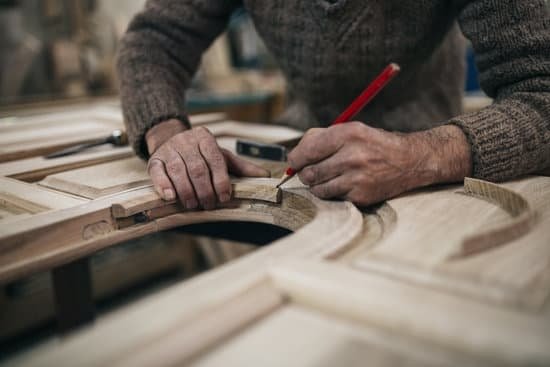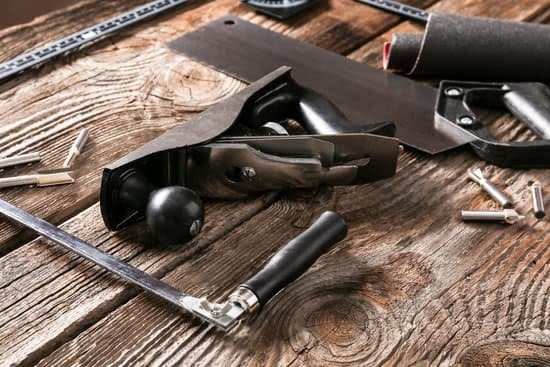Woodworking can be a rewarding and enjoyable craft, but dealing with wood fibers that pull up can be a frustrating challenge for many artisans. Understanding the nature of wood fibers is essential in order to effectively address this issue.
In this informative guide, we will explore the basics of wood fibers, common causes of fiber pulling, precautionary measures to prevent it, essential tools for repair, step-by-step instructions for fixing pulled up fibers, expert tips for maintaining a smooth woodworking surface, alternative techniques for minimizing pulling, and final thoughts and additional resources.
Wood fibers are the structural elements of wood that give it strength and flexibility. When these fibers become damaged or pull up during woodworking, it can affect the overall appearance and quality of the finished product. In this section, we’ll dive into the fundamentals of wood fibers and how they behave in different woodworking scenarios.
By understanding how wood fibers interact with various woodworking techniques and tools, artisans can take proactive steps to prevent fiber pulling before it occurs. We will discuss some common causes of wood fiber pulling in the next section and provide practical tips on how to avoid them altogether.
Common Causes of Wood Fibers Pulling Up
Wood fibers pulling up in woodworking can be frustrating, but understanding the common causes of this issue can help prevent it from happening. One common cause of wood fibers pulling up is working with dull tools. When tools such as saw blades or chisels are not sharp enough, they can tear and pull wood fibers rather than cutting them cleanly.
Another cause is the direction of the grain. If you are not familiar with the grain direction of the wood you are working with, you may end up cutting into the wood in a way that causes the fibers to pull up.
Working Against the Grain
One common mistake that leads to wood fibers pulling up is working against the grain of the wood. This can occur when using hand planes or sanding in a way that goes against the natural direction of the grain. This can result in torn and pulled wood fibers, leaving behind a rough surface.
Moisture Content and Wood Movement
Another common cause of wood fibers pulling up is changes in moisture content and wood movement. As wood absorbs and releases moisture, it can expand and contract, causing stress on the fibers. If not properly accounted for during woodworking, this can lead to pulled and raised wood fibers.
Improper Sanding Techniques
Improper sanding techniques can also contribute to pulled-up wood fibers. Using too much pressure while sanding or moving too quickly across the surface can result in uneven removal of material, leading to torn and raised wood fibers.
By understanding these common causes, you can take precautionary measures to prevent them from occurring and effectively deal with any pulled-up wood fibers during your woodworking projects.
Precautionary Measures to Prevent Wood Fibers Pulling Up
Woodworking can be a fulfilling and satisfying hobby, but dealing with wood fibers that pull up can be a frustrating experience. Understanding the basics of wood fibers is essential in preventing this issue.
Wood fibers are essentially the strands that make up the grain of the wood, and they can easily pull up if not handled properly. The direction of the wood grain plays a crucial role in how likely it is for wood fibers to pull up, and being mindful of this is key in preventing any issues.
One common cause of wood fibers pulling up is using blunt or dull tools. When woodworking, it’s important to ensure that your cutting tools are sharp and well-maintained to avoid causing any damage to the wood fibers. In addition, applying excessive pressure when cutting or sanding wood can also lead to pulled-up fibers. Always let the sharpness of your tools do the work for you in order to prevent any damage.
Another precautionary measure to prevent wood fibers from pulling up is to pay attention to the moisture content of the wood you are working with. Wood that is too dry or too wet can cause the fibers to become brittle or weak, making them more prone to pulling up during woodworking. Using a moisture meter will allow you to accurately determine the moisture content of your wood before starting any project, helping you avoid potential issues with fiber pulling.
| Preventative Measures | Importance |
|---|---|
| Sharp tools | Prevents damage and pulling up of fibers |
| Moisture control | Avoids brittleness or weakness in wood fibers |
Essential Tools for Dealing With Wood Fibers
Woodworking requires specific tools to ensure a smooth and professional finish. When dealing with wood fibers that pull up, having the right tools is crucial to effectively address the issue. One of the essential tools for dealing with wood fibers is a card scraper. This tool is perfect for removing wood fibers that have lifted or torn from the surface. Its sharp edge allows for precise removal of fibers without damaging the surrounding area.
Another vital tool for addressing wood fiber pulling is a block plane. This versatile tool can be used to smooth out uneven surfaces caused by pulled-up wood fibers. Additionally, it can be used to trim and chamfer edges, providing a clean and polished look to the woodworking project.
In addition to these two tools, having a high-quality sanding block is essential for dealing with wood fiber pulling. A sanding block allows for even and controlled sanding, ensuring that the repaired area blends seamlessly with the rest of the surface. With these essential tools in your arsenal, you can effectively address wood fiber pulling in your woodworking projects.
| Tool | Function |
|---|---|
| Card Scraper | Removing lifted or torn wood fibers |
| Block Plane | Smoothing uneven surfaces and chamfering edges |
| Sanding Block | Even and controlled sanding for seamless blending |
Step-by-Step Guide to Repairing Wood Fibers
To repair wood fibers that have pulled up during woodworking, follow these simple steps:
1. Sanding: Using a fine-grit sandpaper, gently sand the affected area in the direction of the wood grain. This will help to smooth out any rough patches and remove any loose fibers. Be careful not to sand too aggressively, as this can cause further damage to the wood.
2. Wetting the Wood: Lightly dampen a clean cloth with water and carefully rub it over the sanded area. This will cause the wood fibers to swell and stand back up, helping to minimize the appearance of pulled-up fibers.
3. Re-sanding: Once the wood has dried, lightly sand the area again with a finer grit sandpaper to remove any raised fibers and smooth out the surface. Be sure to sand in the direction of the grain to avoid causing additional damage.
4. Applying Finish: After repairing the pulled-up wood fibers, apply a finish such as varnish or polyurethane to protect and seal the repaired area. This will help to prevent future damage and maintain a smooth woodworking surface.
By following these steps, you can effectively repair and minimize pulled-up wood fibers, resulting in a professional-looking woodworking project.
Expert Tips for Maintaining a Smooth Woodworking Surface
When it comes to maintaining a smooth woodworking surface, there are several expert tips that can help prevent wood fibers from pulling up. It’s important to understand the nature of wood fibers and how they can be affected by different factors. Here are some expert tips for maintaining a smooth woodworking surface:
1. Use sharp cutting tools: Dull cutting tools can tear at the wood fibers instead of cleanly cutting through them. Ensure that your cutting tools are sharp and well-maintained to prevent unnecessary damage to the wood fibers.
2. Work with the grain: When planing, sanding, or using any other tool on the wood surface, always go with the direction of the grain. Working against the grain increases the likelihood of pulling up wood fibers and creating a rough surface.
3. Proper sanding technique: When sanding a woodworking project, start with a coarse-grit sandpaper and gradually work your way up to finer grits. This helps to smooth out any rough spots without causing excessive damage to the wood fibers.
4. Minimize moisture exposure: Excessive moisture can cause wood fibers to swell and become more prone to pulling up. Store your woodworking projects in a dry environment and avoid working with damp wood whenever possible.
5. Use a sharp hand plane: When using a hand plane, make sure it is properly set up and sharpened. A dull hand plane can cause tear-out and pull up wood fibers, while a sharp one will cleanly shave off thin layers of wood.
These expert tips can help you maintain a smooth woodworking surface by preventing wood fibers from pulling up. By understanding how to work with the natural properties of wood and taking proper precautions, you can create high-quality woodworking projects with minimal fiber damage.
Alternative Techniques for Minimizing Wood Fiber Pulling
Woodworking can be an enjoyable and rewarding experience, but dealing with wood fibers that pull up can be frustrating. In this section, we will explore some alternative techniques for minimizing wood fiber pulling, providing you with additional options to achieve a smooth and flawless woodworking surface.
Use a Backer Board
One effective technique for minimizing wood fiber pulling is to use a backer board when cutting or routing the wood. A backer board acts as a support for the wood fibers, preventing them from tearing out and pulling up. Simply place the backer board underneath the workpiece before making any cuts or routing, ensuring that the wood fibers are fully supported throughout the process.
Wet Sanding
Another alternative technique for minimizing wood fiber pulling is wet sanding. Wet sanding involves using water or mineral spirits to lubricate the sandpaper while sanding the wood. This helps to prevent the sandpaper from catching on the wood fibers and causing them to pull up. Additionally, wet sanding results in a smoother finish and reduces the likelihood of wood fiber pulling, especially when working with softer woods.
Utilize Pre-Stain Conditioner
Applying a pre-stain conditioner to the wood surface before staining or finishing can also help minimize wood fiber pulling. The conditioner penetrates the wood fibers, sealing them and reducing their tendency to pull up during the staining or finishing process. This simple yet effective technique can make a significant difference in achieving a smooth and flawless woodworking surface.
By incorporating these alternative techniques into your woodworking process, you can minimize wood fiber pulling and achieve professional-looking results. Whether using a backer board, wet sanding, or applying a pre-stain conditioner, these methods provide valuable solutions for dealing with troublesome wood fibers that pull up.
Final Thoughts and Additional Resources
In conclusion, dealing with fibers that pull up in woodworking can be a frustrating challenge, but with the right knowledge and tools, it is certainly manageable. Understanding the basics of wood fibers and the common causes of their pulling up is crucial for preventing this issue in the future. By implementing precautionary measures such as using sharp blades and adjusting cutting direction, woodworkers can significantly reduce the occurrence of fiber pulling.
Additionally, having essential tools such as sandpaper, scrapers, and wood fillers on hand can make repairing wood fibers a much easier process. Following a step-by-step guide to repairing wood fibers will ensure that the damaged surface is restored to its smooth state. Moreover, expert tips for maintaining a smooth woodworking surface, such as practicing proper sanding techniques and choosing the right type of wood for specific projects, are valuable insights for any woodworker.
For those who may still encounter difficulties with wood fiber pull-up despite taking precautionary measures and following repair techniques, alternative techniques such as using sealers or applying a shellac finish can help minimize this issue. Ultimately, by being proactive in preventing fiber pulling and knowing how to effectively address it when it does occur, woodworkers can enjoy a smoother and more successful woodworking experience.
For additional resources on this topic, referring to trusted woodworking guides and seeking advice from experienced woodworkers can also provide valuable support and knowledge.
Frequently Asked Questions
How Do You Stop Grain Raising?
Grain raising can be stopped by using a pre-stain wood conditioner before applying the stain. This conditioner helps to seal the wood and prevent the grain from raising, resulting in a smoother finish. Sanding the wood with fine grit sandpaper before staining can also help minimize grain raising.
How Do You Remove Fuzz From Wood?
Fuzz on wood can be removed by lightly sanding the surface with fine grit sandpaper, such as 180 or 220-grit. Sanding in the direction of the wood grain can help to remove the fuzz without causing additional damage to the wood. After sanding, gently wipe away any remaining dust with a clean cloth.
Why Does Wood Get Rough After Staining?
Wood can become rough after staining due to several reasons, including using a dull or improperly-sized sandpaper during preparation, applying too much stain at once, or not allowing the stain to penetrate evenly into the wood. It’s important to properly prepare the wood surface by sanding it and removing any dust before applying the stain.
Additionally, applying multiple thin coats of stain and allowing each layer to dry properly can help prevent roughness after staining.

Hi everyone! I’m a woodworker and blogger, and this is my woodworking blog. In my blog, I share tips and tricks for woodworkers of all skill levels, as well as project ideas that you can try yourself.





